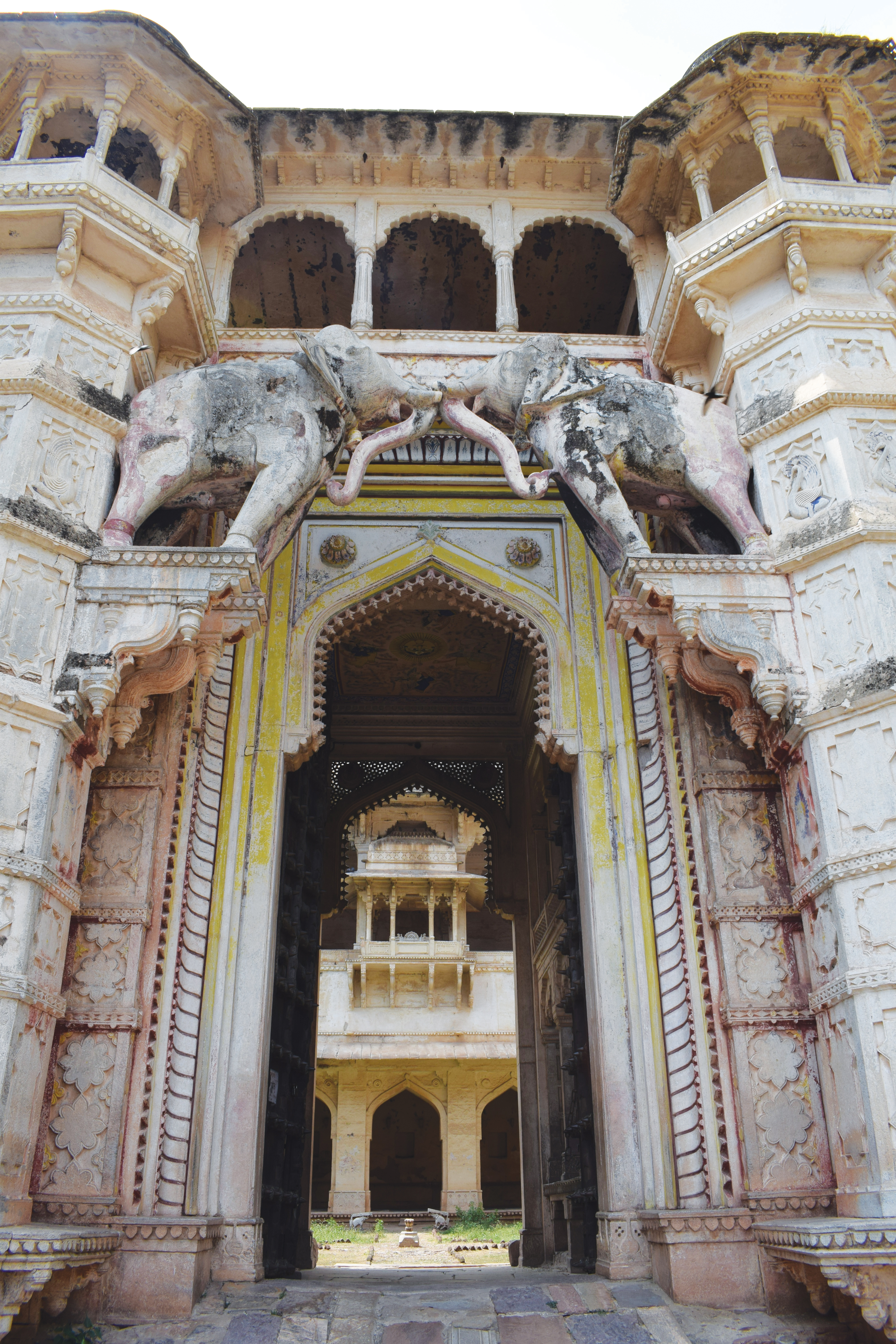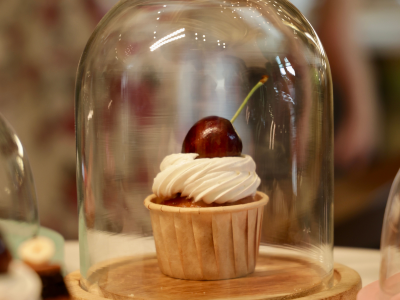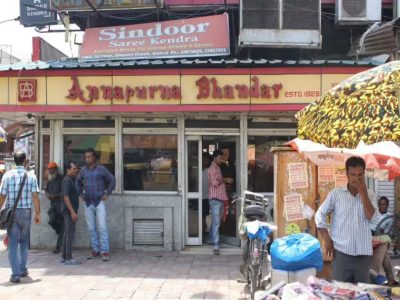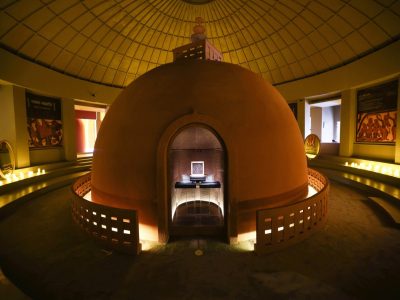From the tribals to the Hadas, the little town of Bundi is home to a magnificent fort, some famous temples and stepwells
Pushing my camera into the bag, I slowly walk down the rocky narrow path to the single shop that the magnificent Taragarh Fort houses. It’s a tricky walk as the rain has made the old rocks slippery and I worry about my gadgets. The rest of the group is stuck near the Chitrashala or art gallery where a garden brightens up the dull ambience of this crumbling structure.
Our guide, Keshav Bhati, is a resident of Bundi. For many decades, he has been taking people on tours and popularising the area. The Fort does not see many visitors for the fee is high. And it could do with some restoration. Its only inhabitants are bats and a caretaker family who also happens to run the single shop selling semi-precious stones.
I walk barefoot on the terrace. The pitter patter of the rain, the dark clouds and the silence making it perhaps the most spiritual walk of the day. The weather gods have been kind, the shopkeeper and his friends tell me. The gemstones are glistening and I am offered a hot cup of tea. I am taken by surprise by this green side of Rajasthan.
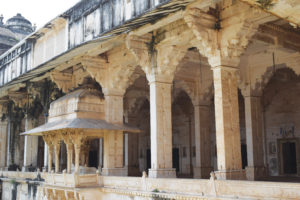
History bells
Way back till the early 12th century, the area was inhabited by tribals and it was named after the local Meena tribal king, Bunda Meena. It was also called ‘Bunda-Ka-Nal’; nal means narrow paths. In 1342, Rai Deva Hada took over Bundi from Jaita Meena and area came to be known as Hadoti or the land of Hada Rajputs. Bundi went under the Mughals in 1568.
Built on a steep hill, the Taragarh fort was where the Hada rulers lived. Constructed in the shape of a star in 1354, the Fort has been called a jewel by Lieutenant Colonel James Tod (1782-1835), a British political agent and author of Annals and Antiquities of Rajasthan. He wrote, “the coup d’oeil of the castellated palace of Bundi, from whichever side you approach it, is the most striking in India.”
Taragarh fort is said to be the first hill fort in Rajasthan. There is a network of tunnels running through the hillside. Built long before the Mughals came to India, the fort’s architecture is unlike the other forts in Rajasthan.
Passage of time
The climb to the entrance is quite steep. The then kings and queens went up on palkis but we use our feet. And then we find ourselves in front of a massive stone entrance, aptly called Hathia Pol. Two elephants are carved at the tall gateway. Inside, the roof is painted with the sun and the stars and the angels. The universe welcomes us to this ancient palace. Even as the rocks stand tall, there are parts which have seen better days. The neglect is seen in the undeterred creepers, the broken pieces and many closed rooms where bats are the kings now. Up a narrow stairway and we reach the area where the king held court. An impressive marble seat tells us this is Deewan-e-Aam. Some frescoes are still visible on an entrance. A lot has faded and a lot is fading. There is a stone with Devanagiri script.
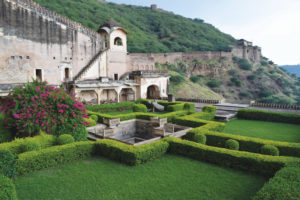
Star attractions
A signboard at the Fort’s entrance gives the major attractions—Hathia Pol, Chattar Mahal, Rani Mahal, Badal Mahal and Phool Mahal. There is also famous cannon here on Bhim Burj, but we don’t see that. Many parts of the fort are closed. There are water reservoirs too.
The Garh Palace has curved roofs, temple columns and ornamental brackets. Here we see Rajputana motifs of elephants and lotus flowers. The locally quarried stone has been used for construction, and that does not support very fine carvings, unlike the red sandstone of the other forts in the state.
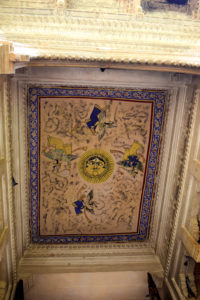
We walk through more passages and reach the courtyard where elephants are carved on the pillars. And there is a room with beautiful frescoes, but it’s only open for the current royal family. With its raw appeal, the fort is not the place to explore alone. I wonder how the queens lived. In every corner, you find something painted, something which has stood the test of time.
The Chattar Mahal was built in 1660. Through more passages and up more steps, we come to a green garden. The meticulous lawn is a reminder that this was frequented by those who loved to create. The walls of this gallery called Chitrashala take my breath away.
This gallery came into existence between 1748 and 1770 during the reigns of Unmed Singh and Bisen Singh. Radha and Krishna adorn a major part of this gallery. Then there are court and hunting scenes, some frescoes even show Rama’s return from the forest. It’s an artist’s paradise and has inspired many, as I am told. While blue is the most predominant colour, green, reds and yellows add to the grandeur. This is the inspiration behind the annual art residency programme organised by jüSTa Lake Nahargarh Palace. These murals are said to be the precursors of other artworks in the state. The clouds rumble as we leave.
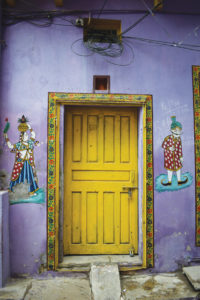
The other side
Out of the fort and into a small market, it’s the weekly off and the street is practically empty. But there are brightly painted walls and interesting signboards on shops. Gopal Soni, an artist, is selling hand-painted postcards as souvenirs in his small shop. He even participated in one of the chitrashalas organised by jüSTa. I enjoy watching the neighbourhood which has vibrant cafes, guest houses, even a tattoo salon. Soon, it’s time to head back to the hotel. But we stop for a few minutes near the mining areas and the shimmering emerald water bodies, but it’s difficult to capture this starkly beautiful landscape in one frame.
More to see
Raniji-ki-Baori, Bundi Palace, Bijasan Mata temple, Jait Sagar Lake
How to reach:
BY AIR: Nearest airport is Sanganer, Jaipur.
BY RAIL: Nearest railhead is Kota Junction, on the Delhi-Mumbai rail route.
BY BUS: It takes about an hour from Kota and around 7-8 hours from Jaipur.

